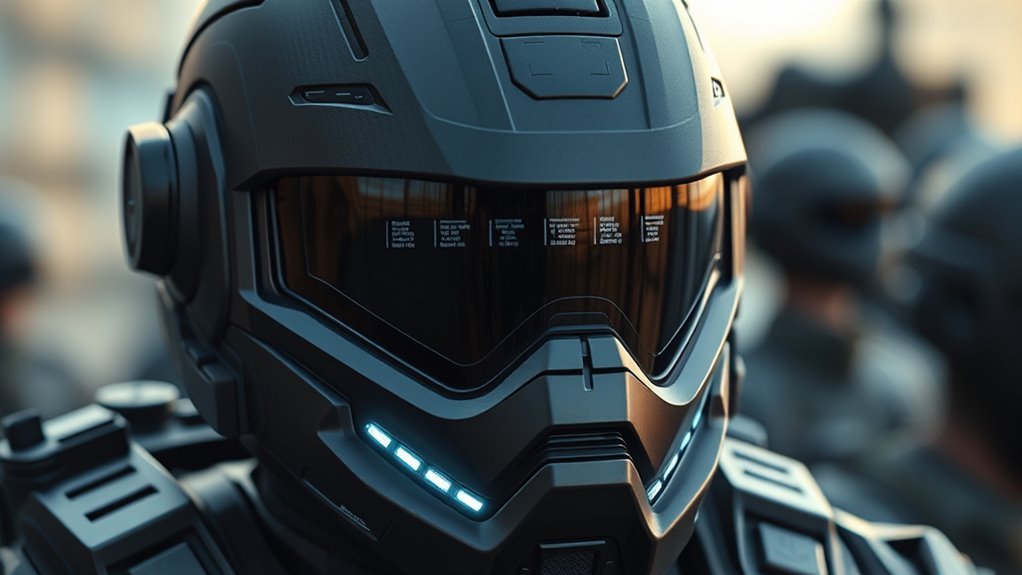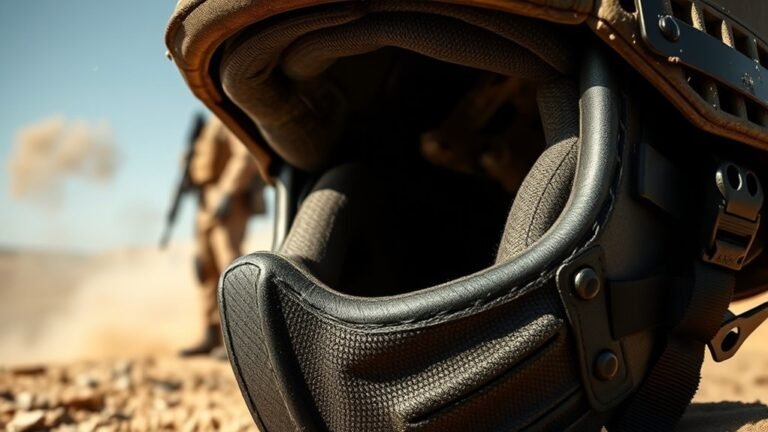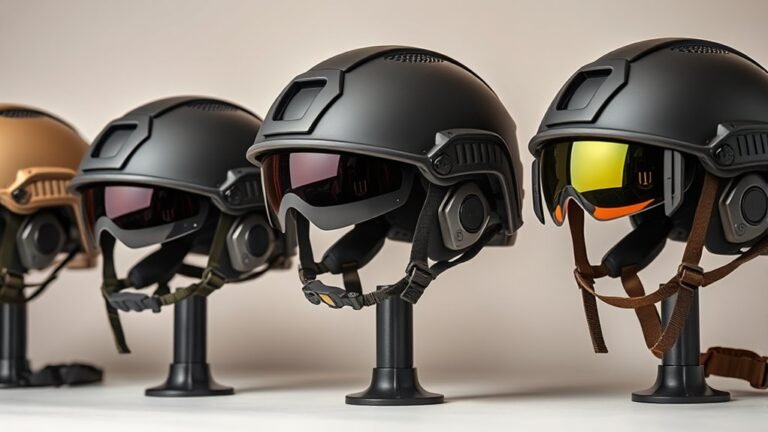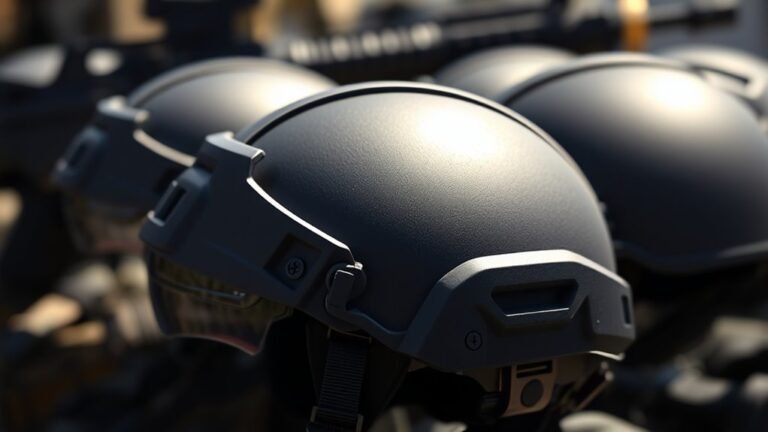Future Technologies in Combat Helmets
Future technologies in combat helmets focus on enhancing soldier safety and performance through advanced materials, integrated health monitoring, and augmented reality. You’ll see innovations like lighter, bio-inspired materials for ballistic protection, real-time physiological tracking, and AR overlays for improved situational awareness. Additionally, smart communication systems will enhance team coordination while adaptive features will provide climate resilience. These advancements ultimately aim to empower soldiers in the field, leading to a transformative impact on military operations. Discovering these developments could reshape combat strategies.
Advances in Materials Science

As advancements in materials science continue to evolve, the development of combat helmets is transforming considerably. You’ll notice that innovative materials, such as bio inspired materials, are becoming central to this transformation. These materials mimic nature’s designs, enhancing durability and functionality while reducing weight. Additionally, the integration of nano coating technologies enables helmets to exhibit superior resistance to environmental factors and impacts. These coatings create a protective barrier that enhances the lifespan and effectiveness of the helmet. By adopting these advanced materials, you not only guarantee enhanced protection but also increased comfort and maneuverability in the field. This evolution underscores a commitment to providing soldiers with the freedom to operate effectively in diverse and challenging environments.
Ballistic Protection Enhancements

When considering ballistic protection enhancements, you’ll notice a strong emphasis on advanced materials development that improves resilience without adding weight. Integrated sensor technology plays a critical role in real-time threat assessment, enhancing situational awareness. Furthermore, innovations in lightweight design are essential for maintaining mobility while ensuring maximum protection.
Advanced Materials Development
While advancements in combat helmet technology are often associated with external features, the core of ballistic protection enhancements lies in the development of advanced materials. By integrating biodegradable materials, manufacturers can reduce the environmental impact of discarded helmets without sacrificing performance. Additionally, nanotechnology applications enable the creation of lighter, stronger composites that improve both protection and comfort. These materials can be engineered at the molecular level, allowing for tailored properties that meet specific battlefield demands. As you consider the implications, it’s clear that the evolution of these materials not only enhances survivability but also aligns with the growing demand for sustainable practices in military equipment. Embracing these innovations empowers soldiers while promoting environmental responsibility.
Integrated Sensor Technology
Advancements in materials have set the stage for the integration of sensor technology within combat helmets, fundamentally enhancing ballistic protection. By employing sensor fusion techniques, these helmets can deliver real-time tactical feedback, improving situational awareness and decision-making on the battlefield.
Here are four key enhancements you can expect:
- Impact Detection: Sensors can gauge the severity of ballistic impacts, alerting you to potential injuries.
- Environmental Monitoring: Sensors assess environmental hazards, ensuring your safety in various combat scenarios.
- Communication Systems: Integrated sensors facilitate seamless communication with your team, essential for coordinated operations.
- Health Monitoring: Real-time physiological data provides insights into your condition, enabling timely medical interventions.
These innovations empower you to face challenges with confidence, ensuring your freedom to operate effectively in dynamic combat environments.
Lightweight Design Innovations
As military operations demand greater agility and responsiveness, lightweight design innovations in combat helmets have become essential for enhancing ballistic protection without compromising comfort. By integrating ergonomic shaping, these helmets fit snugly to your head, minimizing fatigue during extended missions. Advanced materials, such as high-strength composites, allow for a significant reduction in weight while maintaining superior protective capabilities. Additionally, the incorporation of modular components enables customization, allowing you to adapt the helmet for various mission profiles. This flexibility grants you the freedom to equip your helmet with necessary accessories, such as communication systems or night vision mounts, without adding unnecessary bulk. Ultimately, these innovations guarantee you remain agile and protected in dynamic combat environments.
Augmented Reality Integration
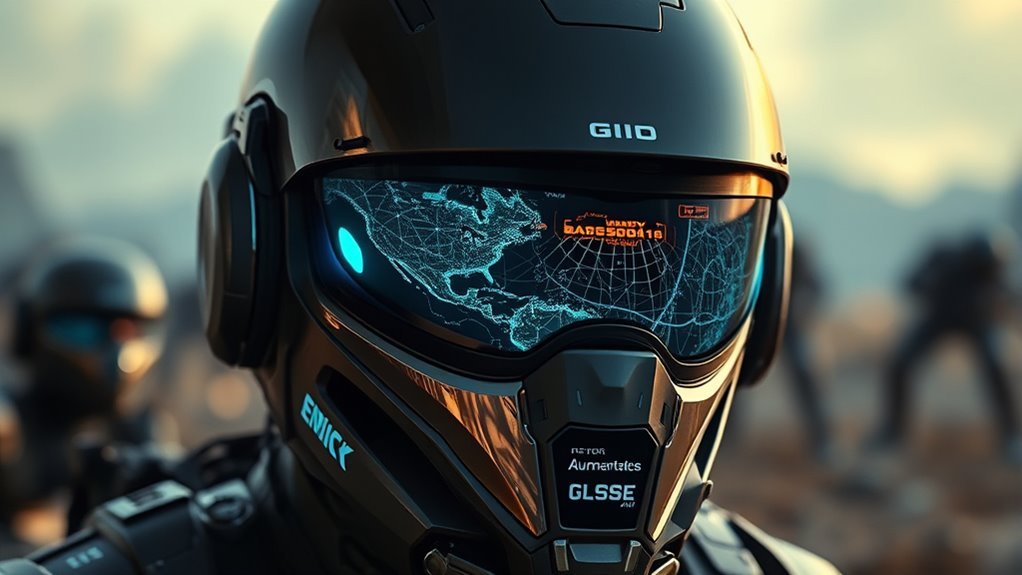
Augmented reality integration in combat helmets greatly enhances situational awareness by overlaying critical information directly into your field of vision. You’ll have access to real-time data displays that can streamline decision-making and improve response times. Additionally, advanced target identification assistance guarantees that you can accurately assess threats and engage effectively on the battlefield.
Enhanced Situational Awareness
While traditional combat helmets have focused primarily on protection and comfort, integrating augmented reality (AR) technology greatly enhances situational awareness for soldiers in the field. This advancement helps mitigate cognitive load and sensory overload, allowing you to focus on critical tasks.
Consider the following benefits of AR integration:
- Real-time threat identification: Instantly recognize potential dangers, ensuring quicker reactions.
- Navigation assistance: Gain accurate positioning data, improving mission efficiency.
- Environmental awareness: Overlay critical information about surroundings, enhancing decision-making.
- Team coordination: Stay connected with fellow soldiers, fostering collaboration and unity.
This technology empowers you to make informed choices, ultimately supporting your freedom and safety in high-stakes environments.
Real-Time Data Display
Building on the enhanced situational awareness provided by AR technology, real-time data display is a game-changer for combat helmets. This capability integrates advanced data visualization techniques, allowing you to access critical information instantly. With intuitive user interfaces, you can monitor essential statistics such as location, status updates, and environmental conditions without diverting your attention from the mission. The seamless overlay of data fosters quicker decision-making, enhancing both individual and team effectiveness in combat scenarios. By transforming complex data into easily digestible visual formats, the helmet’s interface empowers you to maintain superior situational awareness. Ultimately, this technology not only improves operational efficiency but also supports your autonomy in the field, enabling you to make informed choices swiftly.
Target Identification Assistance
As combat situations become increasingly complex, the integration of target identification assistance in helmets through augmented reality (AR) technology offers significant advantages. By leveraging advanced target recognition algorithms and visual enhancement tools, you can experience a transformative edge in the field. Here are some key benefits:
- Enhanced situational awareness: Quickly identify threats amidst chaos.
- Reduced cognitive load: Focus on mission objectives without distraction.
- Improved decision-making: Access real-time data for swift responses.
- Increased survivability: Minimize the risk of friendly fire.
This AR integration not only amplifies your operational capabilities but also empowers you to navigate the battlefield with greater confidence and freedom. Embracing these technologies can redefine your experience in combat.
Smart Communication Systems
Smart communication systems in combat helmets represent a significant advancement in military technology, fundamentally transforming how soldiers interact in the field. These systems enhance tactical communication through integrated wireless connectivity, enabling seamless information exchange among team members. Imagine being able to relay essential intel without the need for cumbersome devices, allowing for quicker decision-making and improved situational awareness. With real-time voice and data transmission capabilities, you can coordinate maneuvers and share critical updates instantly, even in high-pressure environments. In addition, advanced encryption protocols guarantee that your communications remain secure against potential interception. This innovation not only increases operational efficiency but also promotes a sense of autonomy, empowering soldiers to act decisively while remaining connected to their units.
Environmental Adaptability
While environmental conditions can vary dramatically on the battlefield, modern combat helmets are designed to adapt to these challenges, ensuring maximum performance for soldiers. Key features include:
- Climate Resilience: Advanced materials withstand extreme temperatures, protecting you in harsh environments.
- Adaptive Camouflage: Integrated technology changes the helmet’s color and pattern to blend with surroundings, enhancing stealth.
- Moisture Management: Breathable fabrics wick away sweat, ensuring comfort during prolonged operations.
- Weight Distribution: Ergonomic designs reduce fatigue, allowing for greater mobility and focus.
These innovations not only enhance your safety but also empower you with the tools needed to navigate diverse terrains, reinforcing your freedom to operate effectively in any scenario.
Health Monitoring Technologies
Combat helmets are evolving to incorporate sophisticated health monitoring technologies that provide real-time insights into a soldier’s physical condition. By integrating biometric sensors within the helmet, these systems can continually monitor essential signs, such as heart rate and body temperature. This data feeds into advanced health analytics platforms, enabling instantaneous assessments of the soldier’s health status. With these technologies, you can identify potential medical issues before they escalate, ensuring timely intervention. This proactive approach not only enhances individual soldier safety but also optimizes unit readiness. As you navigate the complexities of combat, this blend of technology and health awareness empowers you to maintain peak performance, maximizing your effectiveness on the battlefield while prioritizing your well-being.
Future Trends and Innovations
As the demands of modern warfare evolve, innovations in combat helmet technology are set to transform soldier safety and operational efficiency. Future trends are focusing on integrating advanced features that enhance performance and situational awareness. Here are some key innovations you can expect:
- Neural Interfaces: Direct brain-to-helmet communication could enhance decision-making speed.
- Biomimetic Designs: Helmets inspired by nature could offer better impact resistance and comfort.
- Augmented Reality: Real-time data overlays will keep soldiers informed without distraction.
- Adaptive Materials: Smart materials that adjust to environmental conditions will enhance protection.
These advancements promise to create helmets that not only safeguard but also empower, ensuring you have every advantage in the field. Your freedom depends on the future of protective technology.
Frequently Asked Questions
How Much Do Advanced Combat Helmets Cost?
Advanced combat helmets typically range from $500 to $3,000, depending on features and technology. When you’re conducting a cost analysis, it’s important to factor in durability, weight, and protective capabilities. Budget considerations are essential; higher-priced models often provide enhanced ballistic protection and integrated communication systems. Ultimately, investing in quality helmets can greatly impact safety and effectiveness in the field, making it a critical consideration for any defense budget.
Are There Any Side Effects From Health Monitoring Technologies?
Yes, health monitoring technologies can pose side effects. You might face health risks like skin irritation from sensors or discomfort due to prolonged wear. Additionally, data privacy concerns arise; personal health information could be vulnerable to unauthorized access or misuse. It’s vital to weigh the benefits against these potential drawbacks. Understanding the balance between technological advancement and individual freedom is essential for making informed decisions about adopting such technologies in your daily life.
Can Helmets Be Customized for Individual Soldiers?
Yes, helmets can be customized for individual soldiers, enhancing helmet personalization based on specific soldier preferences. Advances in technology allow for adjustable fit systems, integrated communication devices, and modular attachments tailored to individual needs. This customization not only improves comfort and usability but also enhances operational effectiveness. By considering factors like head shape, weight distribution, and personal gear requirements, a soldier can achieve peak performance and protection in diverse combat scenarios.
How Do Future Helmets Compare to Current Models?
Future helmets integrate helmet innovations and design improvements that greatly enhance protection and functionality compared to current models. Think of the leap from the classic knight’s helm to modern headgear—today’s helmets offer advanced materials, integrated communication systems, and better impact resistance. These upgrades not only improve safety but also provide soldiers with greater situational awareness, enabling them to navigate dynamic environments with increased freedom and efficiency, akin to a warrior equipped with superior technology on the battlefield.
What Is the Expected Lifespan of New Combat Helmets?
The expected lifespan of new combat helmets is greatly enhanced due to material advancements and improved durability expectations. You can anticipate these helmets lasting up to 10 years or more, depending on usage and environmental factors. The integration of advanced polymers and composites not only increases resistance to impacts but also guarantees lighter weights, enhancing comfort during prolonged wear. This means you’ll benefit from better protection without sacrificing mobility or freedom of movement.
